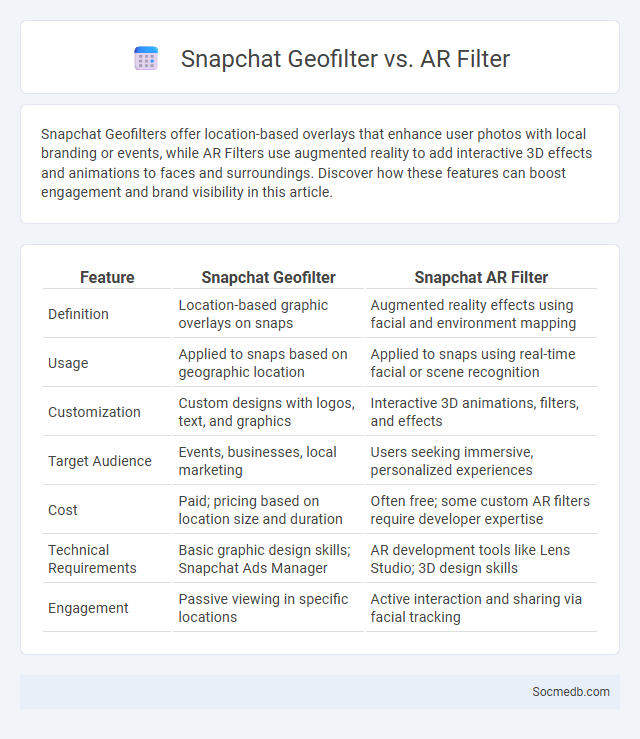
Photo illustration: Snapchat Geofilter vs AR Filter
Snapchat Geofilters offer location-based overlays that enhance user photos with local branding or events, while AR Filters use augmented reality to add interactive 3D effects and animations to faces and surroundings. Discover how these features can boost engagement and brand visibility in this article.
Table of Comparison
| Feature | Snapchat Geofilter | Snapchat AR Filter |
|---|---|---|
| Definition | Location-based graphic overlays on snaps | Augmented reality effects using facial and environment mapping |
| Usage | Applied to snaps based on geographic location | Applied to snaps using real-time facial or scene recognition |
| Customization | Custom designs with logos, text, and graphics | Interactive 3D animations, filters, and effects |
| Target Audience | Events, businesses, local marketing | Users seeking immersive, personalized experiences |
| Cost | Paid; pricing based on location size and duration | Often free; some custom AR filters require developer expertise |
| Technical Requirements | Basic graphic design skills; Snapchat Ads Manager | AR development tools like Lens Studio; 3D design skills |
| Engagement | Passive viewing in specific locations | Active interaction and sharing via facial tracking |
Introduction to Snapchat Filters
Snapchat filters enhance your social media experience by adding creative overlays and effects to your photos and videos, making your content more engaging and visually appealing. These filters use augmented reality technology to transform faces, backgrounds, and environments in real-time, allowing you to express unique moods and styles effortlessly. Exploring popular and trending Snapchat filters can boost your online presence and connect you with a broader audience through innovative, personalized visuals.
What is a Snapchat Geofilter?
A Snapchat Geofilter is a location-based graphic overlay that users can add to their Snaps, enhancing photos or videos with custom designs tied to specific geographic areas. These filters utilize GPS technology to activate only within designated boundaries, making them popular for events, businesses, or local promotions. Businesses and individuals can create and purchase custom Geofilters through Snapchat's platform to increase engagement and brand visibility within targeted communities.
Understanding AR Filters on Snapchat
AR filters on Snapchat enhance your photos and videos by overlaying interactive 3D graphics and animations in real-time, creating immersive digital experiences. These filters use advanced facial recognition and augmented reality technology to track your movements and adapt visual effects accordingly. Mastering AR filters boosts your social media engagement by making your content more dynamic and visually captivating.
Key Differences Between Geofilter and AR Filter
Geofilters are location-based overlays on social media platforms that appear only in specific geographic areas, while AR filters use augmented reality technology to add interactive virtual effects on users' faces or surroundings regardless of location. Geofilters primarily enhance local engagement and event promotion, whereas AR filters focus on personalized, immersive user experiences through real-time visual effects. Both tools serve distinct marketing strategies, with geofilters optimizing localized targeting and AR filters driving interactive brand interactions.
Use Cases: When to Choose a Geofilter
Geofilters enhance your social media campaigns by targeting specific locations, making them ideal for events, local promotions, or brand activations in defined areas. You should choose a geofilter to increase engagement among users physically present at your desired venue, amplifying your message's relevance and driving real-time interaction. Your content gains localized visibility, ensuring it reaches the audience most likely to respond and share within that community.
Use Cases: When to Choose an AR Filter
AR filters are ideal for brands seeking to enhance user engagement and create immersive experiences on platforms like Instagram, Snapchat, and TikTok. You can leverage AR filters during product launches, interactive campaigns, or events to increase shareability and brand awareness. These filters drive personalized interaction, making them perfect for targeting younger demographics and boosting social media visibility.
Customization and Design Options
Social media platforms offer extensive customization and design options that empower users to create unique profiles and engaging content tailored to their brand or personality. Features such as customizable templates, color schemes, typography choices, and interactive elements enhance user experience and boost audience engagement. Advanced tools including AI-driven design suggestions and multimedia integration facilitate professional-grade posts and cohesive visual storytelling.
Cost and Accessibility Comparison
Social media platforms offer diverse cost structures ranging from free access to premium subscription models, ensuring flexibility for different budgets. Accessibility remains a crucial factor, with most platforms supporting multiple devices, including smartphones, tablets, and desktops, enabling you to stay connected anytime, anywhere. Comparing these cost and accessibility features can help optimize your social media strategy for maximum engagement and efficiency.
Engagement and User Interaction Metrics
Social media engagement metrics such as likes, comments, shares, and click-through rates provide critical insights into user interaction and content effectiveness. Analyzing these metrics helps brands understand audience behavior, tailor content strategies, and increase overall reach. High engagement rates directly correlate with improved algorithmic visibility and stronger community building on platforms like Instagram, Facebook, and Twitter.
Which Snapchat Filter is Best for Your Campaign?
Choosing the best Snapchat filter for your campaign depends on your target audience and marketing goals. Filters that incorporate AR elements, like interactive lenses or branded animations, tend to boost engagement and brand recall. Your campaign will benefit most from a filter that resonates with your audience's interests and encourages sharing.
 socmedb.com
socmedb.com